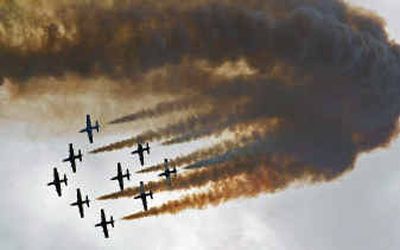Russia holds vintage air show

MONINO, Russia – Historic warplanes buzzed over an airfield outside Moscow on Friday in Russia’s first vintage aircraft show, attracting aviation enthusiasts from several European nations, World War II veterans and thousands of spectators.
Aircrews from Austria, Belgium and the Czech Republic flew planes from the past century to the Monino airfield northeast of the capital for the Flying Legend air show marking Russia’s Air Force Day. The airfield formerly served as a base for Soviet bombers and is now the Russian Air Force Museum.
Camouflage-clad aircraft filled the airfield, which was decorated to represent a Soviet air force base of the World War II era – complete with air defense weapons and maintenance crews. Museum workers donned old uniforms and drove period cars.
The three-day show features flights by about a dozen World War II and postwar aircraft, as well as aerobatic displays by modern Russian fighter jets. The heavily advertised event attracted thousands of visitors from Moscow and the capital’s suburbs to Friday’s opening day.
One of the planes they gawked at was a shining silver B-25 Mitchell, a legendary U.S. bomber of the type that carried out the first American bombing raid on Tokyo and other Japanese cities months after the attack on Pearl Harbor.
“I have been working on airplanes like this for about 30 years, and never in my life I ever thought that I would fly into Russia in an American airplane and participate in an air show,” said Mark Calderwood, a U.S. mechanic with the Austrian-based Flying Bulls company, which owns the B-25.
Russia holds a biannual international air show at another air base near Moscow, but previously did not host shows of historic aircraft.
The silvery Mitchell caught the attention of Soviet air force veterans, including Retired Col.-Gen. Vasily Reshetnikov, who made more than 300 combat sorties during World War II and was in charge of Soviet nuclear bombers at the height of the Cold War.
Reshetnikov, 85, asked the plane’s Austrian pilot, Raimund Riedmann, for a ride and briefly took controls during a demonstration flight. Later, Reshetnikov angrily lamented Russia’s failure to preserve its own vintage warplanes.
“Tens of thousands of planes were cut for scrap, and only now we start looking for old aircraft,” he said.
Unlike many Western nations, the Soviet Union has been notoriously neglectful of its aviation history, not bothering to preserve examples of its legendary warbirds.
Things began to change after the Soviet collapse, when Russian aviation enthusiasts found a growing commercial market abroad for historic Soviet aircraft, the skeletons of which were scattered in forests, swamps and rivers across a country that saw fierce combat during World War II.
In recent years, a Russian defense plant in the Urals city of Orenburg has restored numerous Soviet wartime aircraft or built replicas for foreign collectors, using the wreckage of crashed planes and original design documents.
The plant also built replicas of Japanese Zero fighters that starred in Hollywood’s “Pearl Harbor” epic.